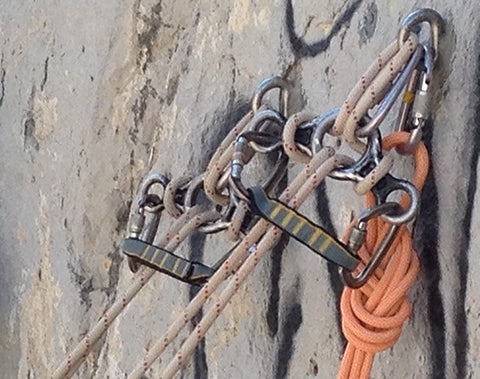Heading out the door? Read this article on the new Outside+ app available now on iOS devices for members! Download the app.
Every Monday we publish the most unbelievable stories of climbing stupidity submitted by our readers. See something unbelayvable? Tell us in the comments and your story could be featured in a future edition, online or in print. For more Unbelayvable, check out the Unbelayvable Archives.
>> I saw a commercial outfitter set this up for their clients. They were rappelling on each of these anchors with figure eight descenders. Is this an art project or is there some purpose that I cannot decipher?—Anonymous, via email

UPDATE: As our readers have pointed out, the above setup is completely belayvable, that is to say, acceptable. This is a rappel system called a Joker. It’s used in canyoneering and allows the user to easily switch between rappelling and lowering. The canyoneer rappels down one strand. If they get into a situation where they need assistance, their partner can take over the job and descend them. The quickdraw, which may look superfluous, actually prevents the rope from falling off the the figure eight descenders should something go wrong. Canyoneering is a complex topic and beyond the scope of our coverage. What may look irresponsible to a rock climber, may be common and acceptable to a canyoneer. For a more in depth explanation of the nuts and bolts of this setup, check out the Joker page on RopeWiki.
In the interest of honesty, and so you can laugh at my ignorance, the original text of the article is below. I apologize for the mistake and fully admit that I am not a canyoneer.
Original text: That is an excellent question, anonymous. I have been starring at this photo for the past 10 minutes, and I only have more questions. What are those quickdraws doing? Why do the quickdraws have locking carabiners? Are those four figure eights supposed to be pre-rigged for the clients? Is that why they’re clipped to the bolts? And if they are pre-rigged, why does only one strand wrap around each descender, when both strands run through the holes? Are those four separate figure eight descenders, or two super figure eights I’ve never seen before? If those descenders are not pre-rigged and, in fact, part of the anchor, then how do they plan to clean it? What’s that bunny ears figure eight knot doing? (That one may be unrelated, but I am curious.) Again, what are those quickdraws doing? And finally, am I the crazy one? Is this a brilliant method for rappelling large groups that I just can’t decipher? I am honestly not sure.
One thing I know for sure is that this anchor is not Timely, from the ERNEST acronym of anchor evaluation (Equalized, Redundant, Non-Extending, Strong, and Timely). Nor is it redundant. If one of those bolts blows, the climber is going to hit the ground. There are two bolts, it never hurts to cover your bases and use them both. It’s also nice when an anchor is simple enough that it can be judged and understood quickly. An easier way to accomplish this in the pictured scenario would be to run a rope through both of the anchor bolts, center it, tie knots in the end of each strand, toss the strands to the ground, and then set up your rappel. Of course, pre-rigging the less experienced members in the group is a great idea. Here’s the method we like. And here’s a video guide to extending and backing up rappels for safe descents.
What do you think? What’s going on in this anchor? Tell us your theory in the comments.
We want to hear your unbelayvable stories! Tell us in the comments and your story could be featured in a future edition online or in print. Got an unbelayvable photo? Send it to unbelayvable@climbing.com.